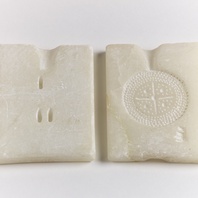
Viking Objects
Reproduction Soapstone Mould
A soapstone (steatite) mould for casting jewellery. This reproduction is double-sided so that it can be used to cast the main brooch or two disc brooches simply by reversing the mould. It is based on known examples of soapstone moulds but the main mould has been created to reproduce the Barker Gate brooch from Nottingham. Soapstone or steatite was widely used in Scandinavia and the Viking diaspora, as it is soft and easily carved, in particular for cooking vessels in cultures that did not produce ceramics. There are soapstone quarries in Norway, Shetland and Greenland. Soapstone objects found elsewhere generally suggest a Viking link to one of these places, though smaller ones are often repurposed from what were originally larger vessels.
Read More
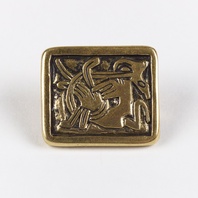
Viking Objects
Reproduction Square Mammen Brooch
This reproduction brooch is based on a small number of Mammen-style brooches found in England. Three rectangular brooches of this type are known from Linwood, Lincolnshire, West Stow Heath, Suffolk, and Bergh Apton, Norfolk, with further examples found in Cambridgeshire and East Anglia in 2015 and 2016. It is a type which has Carolingian-inspired shapes and Scandinavian decoration, which seem to have been produced in the Danelaw, and was an accessory for women who wore Scandinavian dress. Scandinavian brooches came in a variety of sizes and shapes which included disc, trefoil, lozenge, equal-armed, and oval shapes. The different brooch types served a variety of functions in Scandinavian female dress with oval brooches typically being used as shoulder clasps for apron-type dresses and the rest being used to secure an outer garment to an inner shift. Anglo-Saxon brooches do not match this diversity of form with large disc brooches being typical of ninth century dress styles with smaller ones becoming more popular in the later ninth and tenth centuries. However, since disc brooches were used by both Anglo-Saxon and Scandinavian women they are distinguished by their morphology. Scandinavian brooches were typically domed with a hollow back while Anglo-Saxon brooches were usually flat. Moreover, Anglo-Saxon brooches were worn singly without accompanying accessories.
Read More
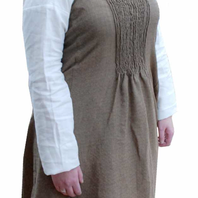
Viking Objects
Reproduction Women’s Clothing Set
The woollen strap-overdress is brown broken-diamond twill. A complete example of this dress has never been found, but this reconstruction is based on a composite of known archaeological finds. The narrow straps are often found mineralised inside the brooches, the pleated front section is based on an archaeological find from Køstrup, in Denmark, and the asymmetrical back panels are based on an original find from Hedeby, in Denmark. The underdress is of bleached linen, based largely on small traces of archaeological material from Birka, Sweden, Dura, Finland, and contemporary depictions. The woollen cloak is of thick yellow diamond twill with fringed edge. The vegetable-tanned leather toggled turnshoes are based on originals found during excavations at Coppergate, in York.
Read More
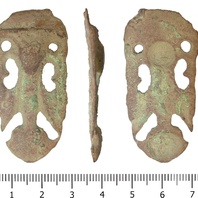
Viking Objects
Tongue-Shaped Strap-End (DENO-1268B3)
An incomplete, copper-alloy strap-end with anthropomorphic designs. These types of strap-ends were popular in both Scandinavia and on the Carolingian continent between the 9th and 10th centuries and were regularly used to embellish baldrics. Strap-ends came in various styles and were fairly common throughout the Viking world. They were used to decorate the ends of belts and to stop them getting damaged.
Read More
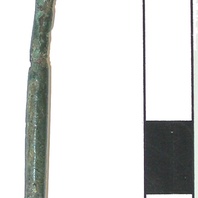
Viking Objects
Expanded-Head Pin (1986/975-AE86)
A copper-alloy pin found at the site of the Little Chester Roman fort. This loose find was found on top of a Roman metalled surface. It has a lozenge-shaped head that is typically Anglo-Scandinavian, but the lack of a secure finds context and its proximity to a Roman surface indicates that it could be Roman.
Read More
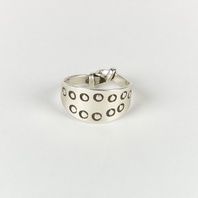
Viking Objects
Reproduction Stamped Finger Ring
A reproduction, stamped, silver ring with knotted ends. Rings with this type of stamped decoration are typical of Scandinavian design during the Viking Age.
Read More
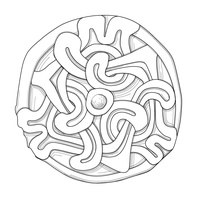
Viking Designs
Drawing of Copper Alloy Disc Brooch
Drawing of a copper alloy, gilded brooch with a zoomorphic design. Brooches were a typical part of female dress. Scandinavian brooches came in a variety of sizes and shapes which included disc, trefoil, lozenge, equal-armed, and oval shapes. The different brooch types served a variety of functions in Scandinavian female dress with oval brooches typically being used as shoulder clasps for apron-type dresses and the rest being used to secure an outer garment to an inner shift. Anglo-Saxon brooches do not match this diversity of form with large disc brooches being typical of ninth century dress styles with smaller ones becoming more popular in the later ninth and tenth centuries. However, since disc brooches were used by both Anglo-Saxon and Scandinavian women they are distinguished by their morphology. Scandinavian brooches were typically domed with a hollow back while Anglo-Saxon brooches were usually flat. Moreover, Anglo-Saxon brooches were worn singly without accompanying accessories.
Read More
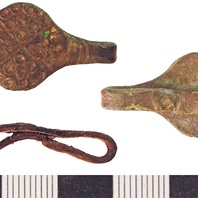
Viking Objects
Imitation Finger Ring (NLM-D675CA)
This finger ring bears stamped decoration imitating the Scandinavian ring and dot pattern which is bordered by incised crossing diagonals of a saltire. The ring- and dot-style of decoration was briefly adopted by inhabitants of Anglo-Saxon settlements such as Cottam in Yorkshire and Flixborough in Lincolnshire.
Read More
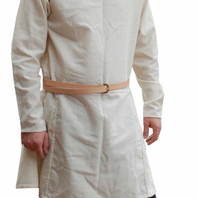
Viking Objects
Reproduction Men’s Clothing Set
The woollen tunic is in white broken diamond twill. Few Viking Age woollen tunics survive intact, but a number of large pieces of skirts and side gores, and arm-hole and sleeve pieces were found at Hedeby, in Denmark. This tunic is made from a composite of all these fragments. The woollen trousers are dark blue/grey herringbone twill. These are based on the archaeological remains of the crotch of a pair of baggy trousers, found at Hedeby, in Denmark, which also appear on a number of Viking Age stone carvings across the Viking world, but particularly in Sweden. The woollen leg-bindingins are yellow herringbone twill, based on original fragments from Hedeby, in Denmark. The vegetable-tanned leather belt, with a ring-and-dot decorated brass buckle, is based on an original found in a male grave (Grave 511), at Repton, Derbyshire.
Read More
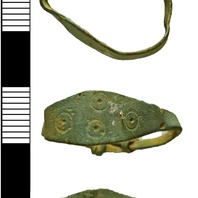
Viking Objects
Stamped Finger-Ring (NARC-031C88)
A stamped copper-alloy finger ring decorated with four double ring-and-dots in a lozengiform arrangement. Ring-and-dot was a decorative technique used at various periods from the later Iron Age onwards, but which enjoyed a Viking Age revival. Rings like this with knotted ends are typically Scandinavian.
Read More
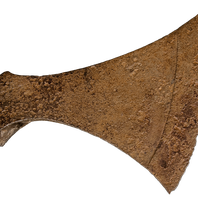
Viking Objects
Socketed Axe (LCNCC:1906.9661.2)
This large socketed iron axe head was found in the River Witham, east of Lincoln, Lincolnshire. Axes were not only a common implement used for a variety of wood-based activities, such as constructing ships, but also were often used as weapons. Axes came in a variety of shapes and sizes depending on their function. Considering the size and shape, this axe was most likely used for warfare rather than as a tool.
